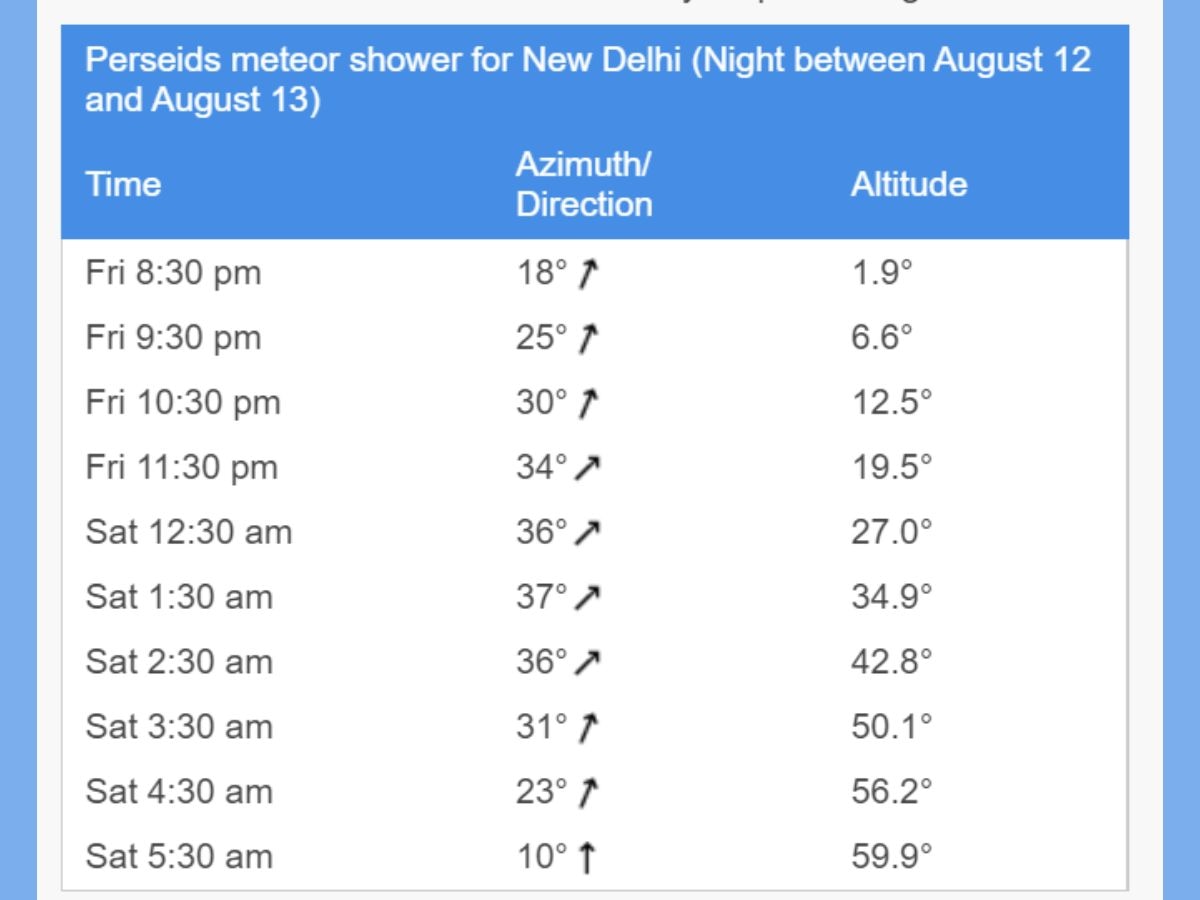Perseids Will Peak Tonight And Tomorrow. How To Watch The Best Meteor Shower Of The Year
Perseids Meteor Shower 2022: Considered the best meteor shower of the year, the Peseids will start peaking Friday, August 12, at around 8:30 pm IST. The Perseids are best viewed in the pre-dawn hours.

The Perseids, which have been active since July 17, will peak tonight and tomorrow. Considered the best meteor shower of the year, the Peseids will start peaking Friday, August 12, at around 8:30 pm IST.
When the Earth runs into the debris field left behind by icy comets or rocky asteroids going around the Sun, meteor showers occur. The comets leave a dusty trail behind them when they come around the Sun.
Earth passes through the debris trails, as a result of which the debris particles burn up in the atmosphere. This leads to the creation of fiery and colourful streaks in the sky.
Every year, the Perseids occur between July 17 and August 24, and peak around August 9 to 13. This year, the Perseids will peak on the night between August 12 and 13.
However, the August supermoon, known as the Sturgeon Moon, peaked in the early hours of Friday, and will appear full through Saturday evening. As a result, the Perseids are likely to be washed out by the brightness of the Moon.
In a statement released by NASA, astronomer Bill Cooke said this year's Perseids will see the "worst possible circumstances for spotters". He added that during the normal peak of the Perseids, the Moon will reduce the number of visible meteors to 10-20 per hour.
Since the Moon is currently brighter than anything else in the night sky, it is likely to wash out everything, including the brightest Perseids as they streak through Earth's atmosphere and burn up far overhead.
How To Watch The Best Meteor Shower Of The Year
In order to see the Perseids, one must go to a place where the skies are clear. Also, the place must be located away from artificial light sources. If the skies are dark and people wait until the early hours of Saturday, they may spot between 15 and 20 meteors per hour.
The meteor shower is best viewed in the Northern Hemisphere during the pre-dawn hours.
Those living in rural areas can enjoy the Perseids from their terrace, due to the absence of light pollution. People living in urban areas can drive to a location far away from their city to see the best meteor shower of the year.
The Perseids will start peaking at around 8:30 am IST on Friday and continue until around 5:30 am IST on Saturday, according to the website timeanddate.com. One can determine the position of the radiant, or the direction which the shower appears to come from in the sky, using the table below.

People can also visualise the Perseids with the help of an interactive page on meteorshowers.org, and can use the drop down menu on the page to change the date.
After reaching the venue to see the Perseids, it may take 15 to 20 minutes for one's eyes to get used to the dark. Once one has found their viewing spot, they should lie down on the ground and look at the sky.
People do not require binoculars or telescopes to see the Perseids, because these equipment may limit the view.
The Peseids will start waning August 21 to 22, and cease completely by September 1.
More About The Perseids
The pieces of debris that interact with Earth's atmosphere to create the Perseids originate from Comet 109P, also known as Swift-Tuttle. In 1865, Italian astronomer Giovanni Schiaparelli realised that the Swift-Tuttle comet was the source of the Perseids. Swift-Tuttle, which takes 133 years to orbit the Sun once, last visited the solar system in 1992.
The Swift-Tuttle comet will not be visible to people on Earth until 2125.
American astronomers Lewis Swift and Horace Tuttle discovered comet Swift-Tuttle in 1862. Swift-Tuttle is a large comet, with a nucleus 26 kilometres across.
During the peak of the Perseids, one may spot 60 to 100 meteors per hour. The velocity of the meteors is 59 kilometres per second.
The swift and bright meteors frequently leave long "wakes" of light and colour behind them as they streak through Earth's atmosphere, according to NASA. Since the Perseids occur at a time when the summer nights are warm, sky watchers can comfortably view the meteor shower.
Perseids are also known for their fireballs, which are large explosions of light and colour that can persist longer than an average meteor streak.
The Perseids are named after the constellation Perseus. This is because their radiant, or the point in the sky the meteor shower appears to originate from, is the constellation Perseus. However, the constellation Perseus is not the source of the Perseids, and only helps viewers in determining the direction of the meteor shower.







































